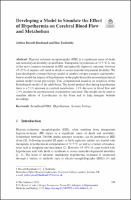Chapter Developing a Model to Simulate the Effect of Hypothermia on Cerebral Blood Flow and Metabolism
Author(s)
Russell-Buckland, Joshua
Tachtsidis, Ilias
Collection
WellcomeLanguage
EnglishAbstract
Hypoxic ischemic encephalopathy (HIE) is a significant cause of death and neurological disability in newborns. Therapeutic hypothermia at 33.5 °C is one of the most common treatments in HIE and generally improves outcome; however 45–55% of injuries still result in death or severe neurodevelopmental disability. We have developed a systems biology model of cerebral oxygen transport and metabolism to model the impact of hypothermia on the piglet brain (the neonatal preclinical animal model) tissue physiology. This computational model is an extension of the BrainSignals model of the adult brain. The model predicts that during hypothermia there is a 5.1% decrease in cerebral metabolism, 1.1% decrease in blood flow and 2.3% increase in cerebral tissue oxygenation saturation. The model can be used to simulate effects of hypothermia on the brain and to help interpret bedside recordings.


 Download
Download